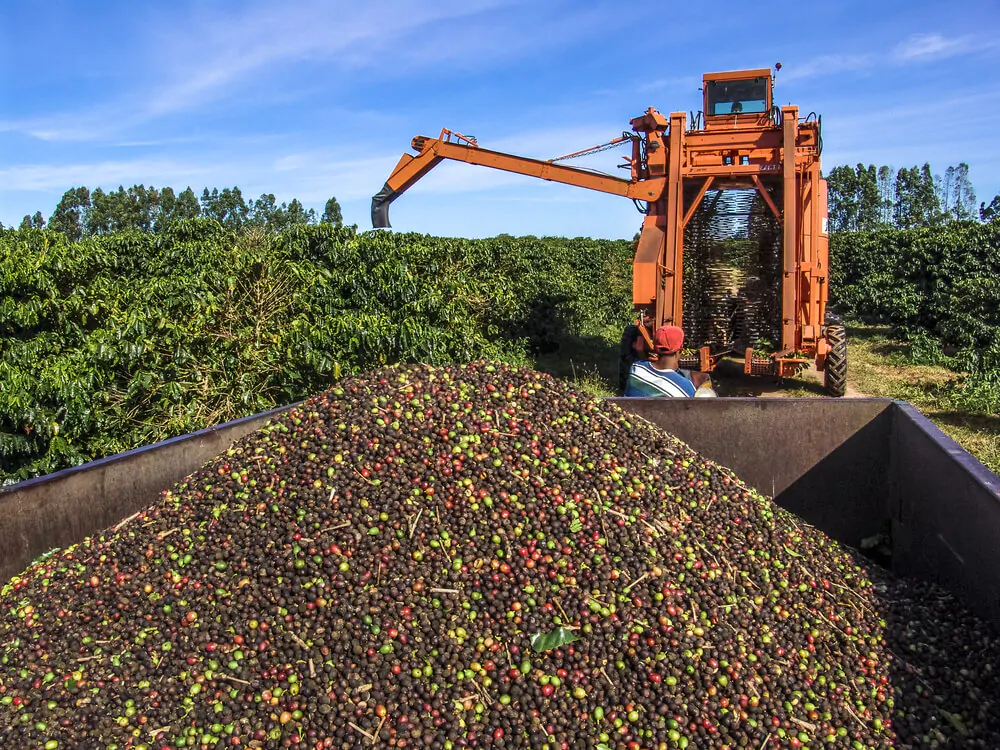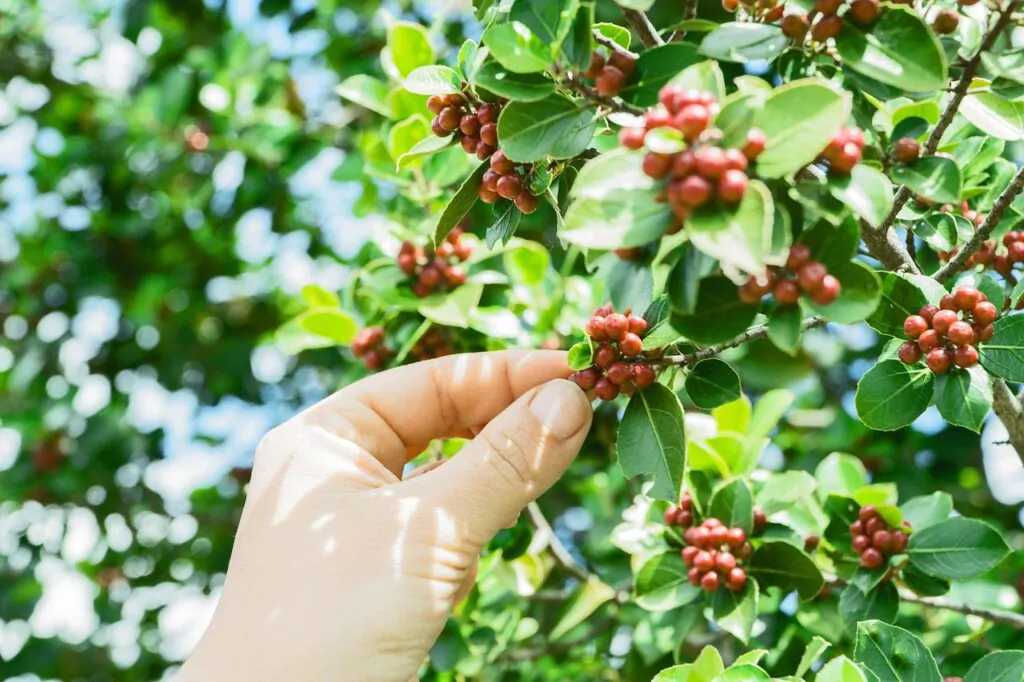While the traditional way of harvesting coffee beans is by hand-picking, can coffee be harvested by machine? Keep reading to find out.

Coffee can be harvested by machine for more than 30 years now. There are a several brands of mechanical harvesters available, but they all have essentially the same parts and designs.
Almost all mechanical harvesting systems have diesel motors operating large hydraulic pumps. This hydraulic pump then operates the hydraulic rams and other smaller hydraulic motors all over the machine, which also operate the wheel drivers, conveyors, steering, shakers, height adjustment, and cleaning fans.
Mechanical harvesters essentially straddle the row of trees, meaning the tree ends up inside the harvester. They have heavy counterweights that are supported by two columns, operated at customizable speeds — as the weights spin, the columns rotate.
The coffee cherries are picked off by the vibration. There are “fish plates” beneath the columns. These are polycarbonate sheets that are angled and attached to the springs that take up the gaps between the tree trunks. The coffee cherries roll to the internal horizontal conveyors, and then into the other conveyors, and eventually to the holding bin. You might also be interested in our washed coffee vs. natural coffee guide.
The Main Brands Of Coffee Harvesters
The most notable coffee harvester brands are Korvan and Brastoft (formerly known as Austoft). While the size and shape of both machines are essentially the same, a few differences significantly impact the quality and quantity of the coffee cherries harvested.

Korvan Harvester
The Korvan harvester is operated from the machine’s top center, making it easier to travel through the row since the trees are directly beneath the operator. This machine has a strong and variable speed fan cleaning system, to eliminate waste.
The Korvan harvester has a bin holding about one ton of coffee cherries and unloads by lifting and tipping over. However, since it is quite long, you either need a Korvan trailer, two field bins placed side by side, or you can modify the top of the bin into a funnel to unload the coffee cherries.
The conveyor system on the Korvan harvester is gentler but more prone to damage or halting since the columns and top conveyors are plastic. It also has an over-the-row conveyer, which allows a tractor with a trailer to drive in the next row, and the coffee cherries are dropped into this trailer.
Check out our explainer on why hand-picking is better for harvesting coffee beans.
Brastoft Harvester
The Brastoft harvester is operated at the same level as the trees on the left of the row. This makes it quite difficult to move, especially so if the row is not linear or is overgrown. However, the major advantage of operating is that you can get a closer look at determining the number of ripe and unripe coffee cherries and change the speed of the shaker for every tree.
The Brastoft harvester has a motor-driven retard coupling on its shaker system that the driver can adjust. This prevents the columns from rotating rapidly even when the shaker weights are running at a higher speed or even if there are no trees inside the fingers. This feature causes a stronger but even more selective shaking of the tree and an increased rotation through the picking rods.
The Brastoft harvester can be greatly enhanced by removing and replacing the picking rod holders with Korvan rod holders since they are sturdier. In addition, the new picking fingers will be longer than the original ones from Brastoft or Korvan. The added length means the harvester can be more selective in harvesting coffee cherries.
The Brastoft harvester has a bin holding about one ton of coffee cherries with two small openings on the bottom. Like the Korvan harvester, it also has an over-the-row conveyer.
The Coffee Harvesting Methods
There are two coffee harvesting methods — selective harvesting and strip harvesting.
Selective Harvesting
In selective harvesting, only the ripe coffee cherries are picked by hand — the unripe ones are left behind. Overripe coffee cherries can be left too, but picking them and separating them from the ripe cherries is advised. Later, the harvesters will come back to pick only the ripe coffee cherries again.

Harvesters fill their baskets with ripe cherries. Once the baskets are full, they are then poured into a big collection bag. All the coffee cherries harvested will be spread out, and the unripe cherries, overripe cherries and debris, will be removed.
Pros
- Only the ripe coffee cherries are picked, which results in fewer unripe coffee cherries in the harvest and better prices for the producers.
- Since the coffee cherries are picked by hand, they do not need to be planted in a line, so farmers can use slopes to get the most use of farmland.
Cons
- Hand-picking typically relies on a substantial rural labor force open to working for minimum wage.
- As minimum wage increases, producers struggle to meet the cost of labor.
- As the urban population increases, the rural workforce decreases.
Strip Harvesting
In strip harvesting, all coffee cherries are “stripped” off of the tree mechanically, which results in a harvest with different levels of ripeness.
Here are common strip harvesting methods:
Manual Stripping
For this method, the harvesters place a canvas on the ground. Then, pull a branch outward and knock the cherries to the ground. This process is repeated with every branch along the canvas. The cherries are collected in bags, which are weighed at the end of the day.
Mechanical Stripping
Mechanical stripping is like manual stripping, but only with a little mechanical assistance. Harvesters rely on derricadeiras, which are mechanical strippers on weed eaters.
The harvesters place a canvas on the ground. But this method uses the derricadeiras to shake the coffee cherries onto the ground. After repeating this process, they will collect the coffee cherries and then put them into bags, to be weighed at the end of the day.
Mechanical Harvesters
The final way to harvest coffee via stripping is by using a mechanical harvester. This type of machine uses vibrating and rotating picking rods to shake the coffee cherries from the tree into the holding bin.
They can also be adjusted to reduce the yield of unripe coffee cherries by adjusting the rates of vibration and rotation. They can also adjust how quickly the mechanical harvester moves through the tree rows. This method of selective harvesting requires a very flat topography to be able to accommodate such heavy machinery.
Pros
- Strip harvesting does not rely on as much manual labor.
- Quicker.
Cons
- Strip harvesting produces varying maturation levels. This can result in uneven drying and poorer quality of products if the cherries are not separated.
- Coffee producers need sufficient post-harvest tools like pulpers or optical sorters to achieve the best possible quality.
- The heterogeneous lots created by this method can cause higher yields of unripe coffee cherries, which can reduce quality and profits.
You may also be interested in reading our guide on how coffee is harvested.
Which Coffee Harvesting Method Is More Productive?
Their productivity may depend on the situation. Sure, the main goal is to produce the best quality coffee, but there’s a lot to consider, so they need a harvesting method that does not require too much money, time, etc.

Harvesting coffee cherries by hand takes a lot of time and effort. Not only that, but you also tend to harvest the same coffee repeatedly, making it less cost-effective.
On the other hand, some coffee farmers harvest coffee cherries using the stripping method when nearly 75% to 80% of the crop is fully ripe. Perhaps the stripping method is suitable and cost-effective for them, but you will sacrifice the quality of the coffee.
Remember that the mixture of ripe and unripe coffee cherries will probably result in a product of lower quality. The stripping method may be more productive, but unless you separate and discard the unripe and overripe coffee cherries, the hand-picking method will still be better when it comes to quality.
Any coffee harvesting methods have both positive and negative effects. Thus, coffee farmers need to consider the overall impact on their business.
You may also be interested in reading our guide on how is coffee grown – the process of coffee production.
